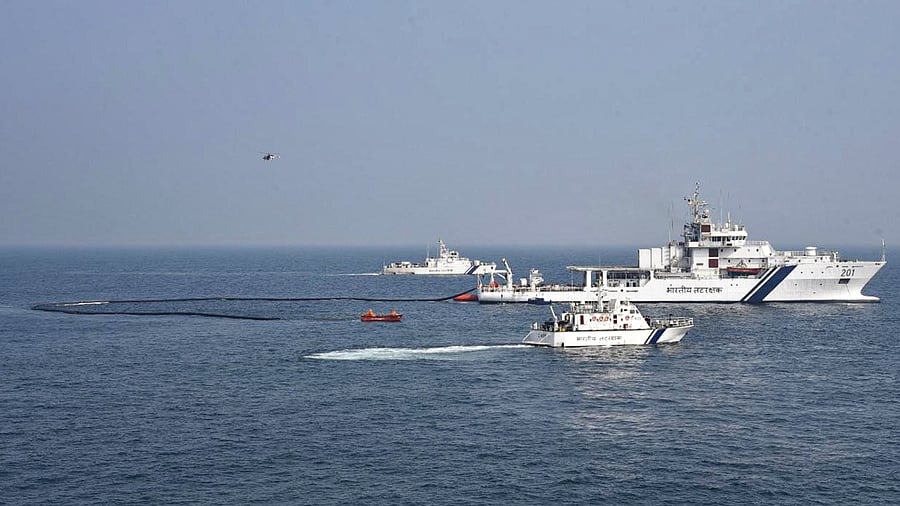
The Indian Coast Guard personnel (Representative image)
Credit: PTI Photo
Tahawwur Rana, a key accused in the 26/11 seaborne terror attack on Mumbai, who has been extradited from the US to stand trial in India, is a big security victory for the country. While it is an important step towards closure of the probe, it also serves as a reminder of the challenges that continue to plague India’s coastal security management. Especially considering that lately there have been some incursions into India’s territorial waters, though benign in nature.
India’s nine coastal states and four Union Territories (UTs) are concerned with coastal security management. While the Centre is aware of the importance of coastal security, most state governments, unfortunately, remain lukewarm to this effort, citing financial constraints. They are also keen that the Centre takes on the entire responsibility for coastal security. This, despite the Centre incurring heavy expenditure on several measures adopted after 26/11 in the form of Coastal Security Schemes I and II.
After 26/11, the Centre created a three-tier coastal security architecture. The State Marine Police (SMP) of the 13 coastal states and UTs created after 26/11 are mandated to patrol up to 12 nautical miles (nm) from the coast, the Indian Coast Guard (ICG) from 12 nm to 200 nm and finally the Indian Navy (IN) beyond the EEZ of 200 nm. The Customs Marine Wings (CMW) under the Ministry of Finance also have boats and patrol close to the coast. Clearly the IN, ICG, SMP, and the CMW, are all involved in coastal security. Unfortunately, the SMP and CMW lack a specialised ‘sea going cadre’ or adequate training facilities and suffer from many operational, maintenance and logistics constraints.
They require support from the agencies concerned, especially the ICG, to enhance their capacity and capability to undertake effective patrolling at sea. The national security bureaucracy is invariably preoccupied with the more visible hotspots in Jammu and Kashmir, the northeastern region, and along the Naxalite-Maoist insurgency-affected Red corridor. But as the security grid is tightened around the land borders, the loosely guarded coastal borders are becoming even more vulnerable, especially with the emergence of new technologies such as drones.
Significantly, since the US military exit from Afghanistan in August 2017, the IN and the ICG in coordination with intelligence and other agencies have had several narcotics hauls in the Arabian Sea. This contraband emanates from the Golden Crescent exits through Pakistan’s Makran coast on fishing trawlers and are transshipped mostly off the Lakshadweep Islands, to other crafts bound for India, Maldives, Sri Lanka as also to Europe, Africa, Southeast Asia, Australia etc. Invariably, criminal elements who indulge in drug smuggling are also involved with gun-running which poses a security threat.
China on the move
Lately, there has been a surge of Chinese maritime activities in the Indian Ocean Region (IOR) with regular forays of warships, submarines, research vessels, and satellite-tracking ships. Chinese fishing trawlers which often have a role of intelligence collection, abound off India’s EEZ. Bangladesh is going through a political upheaval. Myanmar too is in a state of flux. There is also a resurgence of maritime piracy off Somalia.
The Navy and the Coast Guard are the country’s major maritime security agencies with the former responsible for overall maritime security, including coastal and offshore security. The IN is busy with macro security challenges like the Indo-Pacific Initiative and the Quadrilateral Security Dialogue and is spread thin. Meanwhile, the ICG has over the last almost five decades evolved into a credible maritime force. Extensive involvement of the Navy in coastal security could affect its primary war-fighting role. Coastal security is, therefore, best left to be led by the ICG.
While the IN reports to the Chief of Defence Staff (CDS) who heads the Department of Military Affairs (DMA) in the MoD, the ICG reports to the Defence Secretary, also in the MoD. From all indications, the ICG may not be a part of the soon to be implemented Integrated Theatre Command, which is a dichotomy.
The Border Management Division of the Home Ministry oversees both the country’s land and coastal borders. It is only proper, therefore, that the ICG be placed under the Border Management Division and made exclusively responsible for coastal security.
Maritime security and its component of coastal security are critical considering that India’s coastline has been recently revised upwards from 7,516 km to 11,098.81 km, thanks to new technologies and measurement techniques. While one hopes that 26/11 will never repeat, the fact is that there is no such thing as ‘total watertight security’.
(The writer is a former naval officer and a former director in the Cabinet Secretariat)